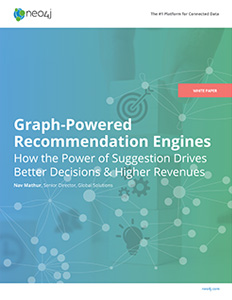
Real-time recommendation engines are key to the success of any online business. To make relevant recommendations in real time requires the ability to correlate product, customer, inventory, supplier, logistics and even social sentiment data. Moreover, a real-time recommendation engine requires the ability to instantly capture any new interests shown in the customer’s current visit – something that batch processing can’t accomplish. Matching historical and session data is trivial for a graph database like Neo4j.
The key technology in enabling real-time recommendations is the graph database, a technology that is fast leaving traditional relational databases behind. Graph databases easily outperform relational and other NoSQL data stores for connecting masses of buyer and product data (and connected data in general) to gain insight into customer needs and product trends.
Whether you’re leveraging declared social connections or connecting the dots between seemingly unrelated facts to infer interests, graphs offer a world of fresh possibility when it comes to making better real-time recommendations for your users. Connect people to products, services, information or other people based on their user profile, preferences and past online activity such as product purchases.
Enable users to search for products, services or people based on a host of fine-grained criteria and continually improve recommendations by accommodating new data sources and types – without an intensive re-write of your data model.
Whether the recommendation engine uses collaborative- or content-based filtering, it needs to traverse a continually growing, highly interconnected dataset.
The power of a recommender system lies in its ability to make a recommendation in real time employing users’ immediate history. However, traversing a complex and highly interconnected dataset to provide contextual insights is a challenge without the right technology.
The accuracy and the scope of recommendations increase as you add more nodes or data points. The rapid growth in the size and number of data elements means the suggestion system needs to accommodate both current and future requirements.
Unlike relational databases, Neo4j stores interconnected user and purchase data that is neither purely linear nor hierarchical. Neo4j’s native graph storage architecture makes it easier to decipher suggestion data by not forcing intermediate indexing at every turn.
Neo4j’s versatile property graph model makes it easier for organizations to evolve real-time recommendation engines as data types and sources change.
Neo4j’s native graph processing engine supports high-performance graph queries on large user datasets to enable real-time decision making.
The built-in, high-availability features of Neo4j ensure your user data is always available to your mission-critical recommendation engine.
Case Study
Read this case study about how ATPCO uses Neo4j for a responsive pricing engine that meets the performance and scalability standards of the airline industry.
Case Study
Nathaniel Felsen, DevOps engineer at Medium, talks about how they are using Neo4j for building a social graph and recommendations for a personalized content experience.
Case Study
Learn how eBay used Neo4j to build a shopping app with natural language understanding and artificial intelligence.

What does your customer really want next? The context and relationships within your data decides the success of your enterprise in an increasingly competitive world.
Your enterprise is driven by connections – now it's time for your database to do the same. Click below to download and dive into Neo4j for yourself – or download the white paper to learn how to leverage the power of graph technology for more relevant and personalized recommendations.
Neo4j has been downloaded over 2 million times and has a large global community of developers.